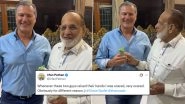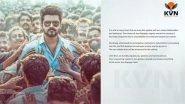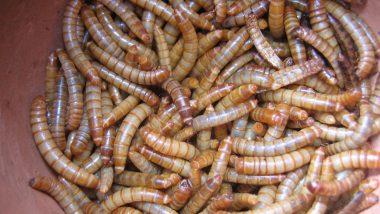Mumbai, November 14: Can a tiny insect help solve the world’s plastic pollution crisis? Researchers have found that mealworm larvae, specifically the Kenyan lesser mealworm, can consume and break down polystyrene, one of the most common yet persistent plastics polluting the planet. This unique discovery highlights how these insects, native to Africa, might play a role in degrading plastic waste and offer new hope in the fight against pollution, especially in countries struggling with high levels of plastic waste. The larvae of the Alphitobius darkling beetle can digest Styrofoam due to the presence of specialised bacteria in their guts, which assist in breaking down the complex polymers of the plastic.
According to a report by Down To Earth, scientists from the International Centre of Insect Physiology and Ecology (ICIPE) in Kenya conducted a study showing how the lesser mealworm larvae can break down polystyrene, turning it into simpler compounds. A report by Live Science further highlights that this research not only helps us understand the insect's natural ability but also suggests future possibilities for scaling this process to reduce plastic waste. The bacteria involved in this degradation process could be harnessed for industrial applications, providing a sustainable alternative to traditional recycling methods. Band-Aid on Open Wounds Causes Cancer? Study Finds Cancer-Causing Forever Chemicals in Popular Bandage Brands Including Johnson & Johnson.
What Are Kenyan Lesser Mealworms?
The Kenyan lesser mealworm is the larval form of the Alphitobius darkling beetle, an insect species believed to be native to Africa, especially found in poultry-rearing houses where warmth and food sources are plentiful. These larvae thrive in warm, nutrient-rich environments, making them efficient feeders with a high survival rate under the right conditions. Though lesser mealworms have spread globally, the specific subspecies found in Kenya may have unique traits, particularly its ability to eat plastic, a capability that has intrigued scientists studying natural solutions for waste management. What Is AI Superintelligence? Can It Take Over the World and Destroy Humanity? What Are the Risks?
In a recent study conducted by researchers at ICIPE in Kenya, the Kenyan lesser mealworm larvae were found to consume polystyrene, commonly used in packaging materials like Styrofoam. The larvae’s ability to digest this plastic stems largely from bacteria in their gut, which help break down complex polymers into simpler compounds. The study fed the larvae with a diet of polystyrene alone, a combination of polystyrene and bran, and bran alone, discovering that mealworms fed a mixed diet of plastic and bran were more efficient at breaking down polystyrene with approximately 11.7 per cent than those fed plastic alone.
The researchers analysed the bacterial communities in the larvae’s gut, identifying key bacterial strains such as Kluyvera, Lactococcus, and Klebsiella that produce enzymes capable of degrading plastic. These bacteria adapt to the larvae's plastic diet, enabling the mealworms to break down and process the plastic effectively. The study’s findings hold promise for future waste management solutions; by isolating and reproducing these bacteria and enzymes, scientists could develop eco-friendly methods to tackle plastic pollution, particularly in countries with limited recycling infrastructure.
(The above story first appeared on LatestLY on Nov 14, 2024 10:39 PM IST. For more news and updates on politics, world, sports, entertainment and lifestyle, log on to our website latestly.com).













 Quickly
Quickly


